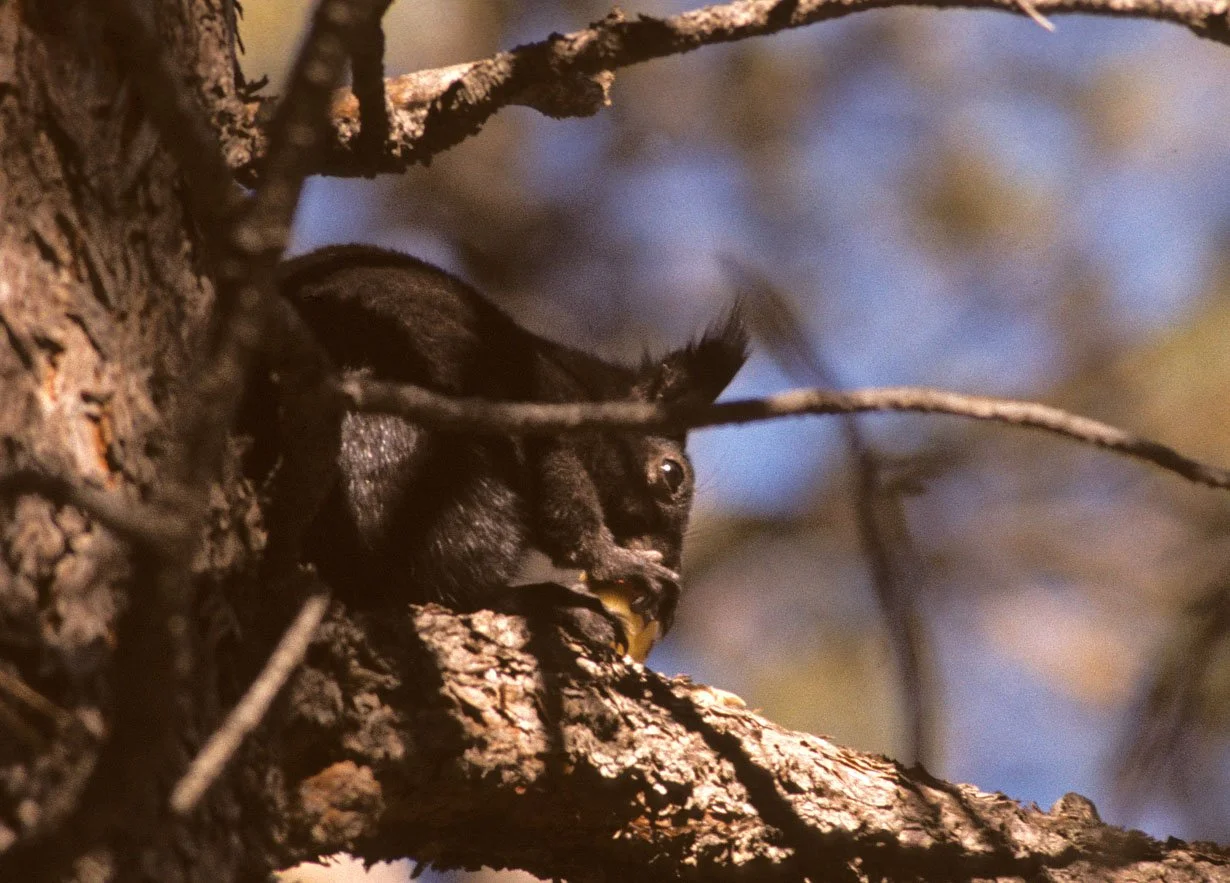April Nature Almanac: Outfoxed by Fox Squirrels
Stephen Jones and Ruth Carol Cushman
April 2025
In early spring, sparrows, siskins, finches, and other seed-eating birds flock to our backyard feeders, stocking up on calories to fuel nesting activities. Meanwhile, neighborhood fox squirrels are busy providing milk and nuts for their first brood of young, and there’s hardly anything more attractive to fox squirrels than bird feeders.
Many of our fox squirrels have a reddish tinge, which can cause people to confuse them with the smaller eastern red squirrel. Photo by Stephen Jones.
The ensuing cat and mouse game between the birdwatchers and squirrels can grow frustrating or hilarious, depending on your point of view. And it’s the squirrels who often get the last laugh.
Birdwatchers have used baffles, habanero peppers, mild electric currents, and other deterrents (including pulling on the squirrels’ tails when they stick their heads into the bird feeders) with mixed results. So adept are these largest of North American tree squirrels at leaping, climbing, slithering, and general problem solving, that some admirers have constructed intricate “squirrel mazes” to challenge them.
One of our favorites is the “Backyard Squirrel Maze 2.0” designed by Mark Rober (viewable on You Tube). This nine part, high tech maze utilizes air ducts, moving bricks, and spinning perches to challenge the squirrels, who must press a button activating a computer access code to open the final door leading to the feeder.
It goes without saying that Rober’s backyard family of four squirrels overcomes all these obstacles without too much trouble, eventually making off with a feeder full of walnuts.
In the comments section of the video, one viewer writes: “Watching a squirrel actually memorize the path of the maze by looking at it from the outside, and then going inside and get it perfectly on the first try was one of the most mind-blowing things I’ve ever seen.”
Though our pine squirrels feed primarily on Douglas-fir, Engelmann spruce, and subalpine fir cones, fox squirrels compete with them for chokecherries, beaked hazelnuts and other wild foods along streams in the foothills.
So how do they do it? Evolutionary ecologists have pointed out that tree squirrel survival depends on their ability to find and extract food from hidden crevices in trees and under tree roots. Once they find a food item, they often bury it, so their survival also depends on their ability to remember where they put it.
These combined traits make fox squirrels very good at solving mazes, and once having solved a maze, remembering the route through it. Their frequent association with humans and human environments helps as well, since they are not put off by human-constructed objects.
Urban-adapted generalists, such as fox squirrels, raccoons, Blue Jays, and crows, are sometimes described as being “highly intelligent” based on their ability to solve human-oriented problems. But what takes more “intelligence,” learning how to extract food from a feeder or garbage can--or finding your way, as Yellow Warblers do, from a rain forest in Central America to a lone cottonwood tree on the North American prairie, traveling most of the way at night using the stars and the Earth’s magnetic field as guides?
Male Yellow Warbler back in Boulder County for a breeding season. Photo by Kevin Smith.
Or imagine a monarch butterfly emerging from her chrysalis in Minnesota and flying south 2000 miles to overwinter on a mountaintop in Michoacán that she’s never seen before. It seems that most all beings are geniuses when it comes to doing what they require to survive. Characterizing their levels of intelligence based on these feats leads us down a slippery slope.
Fox squirrels, who are native to the eastern half of North America, have used their ability to thrive among humans to expand their range westward, following deciduous tree corridors and human settlements across the western plains and into the Rockies. As they clip cottonwood blossoms and stash various fruits and seeds in the ground, they help to spread the riparian woodlands that sustain them.
In Boulder County, they’ve made it all the way up to Nederland and Allenspark. Throughout our foothills ponderosa pine forests, they’ve displaced populations of native tassel-eared squirrels and may compete with native pine squirrels.
Tassel-eared Abert’s squirrels are habitat specialists who thrive in ponderosa pine woodlands. Some of their territories west of Boulder have been claimed by aggressive fox squirrels. Photo by Stephen Jones.
They also eat eggs and young of Western Kingbirds, American Robins, Red-eyed Vireos, and other birds who nest in deciduous trees. Along with many other urban-adapted generalists, they’ll continue to displace native habitat specialists so long as humans introduce deciduous trees and provide supplemental food sources.
We are saddened when we see this process unfolding. But when we hear people exclaim, “I hate fox squirrels,” we can’t help feeling that they may be directing their anger at the wrong species.
Other April Events
Otters, mink, long-tailed weasels, beavers, raccoons, foxes, and porcupines are born.
Young prairie dogs appear above ground.
Swainson’s Hawks return from Argentina.
Broad-tailed Hummingbirds pass through the lowlands en route to nesting sites in the foothills and mountains.
Bullsnakes mate.
Nature Almanac is a monthly series by Stephen R. Jones and R. Carol Cushman, along with other guest contributors. Ruth Carol Cushman and Stephen Jones are authors of A Field Guide to The North American Prairie (Peterson Field Guides) and Wild Boulder County: A Seasonal Guide to the Natural World.




